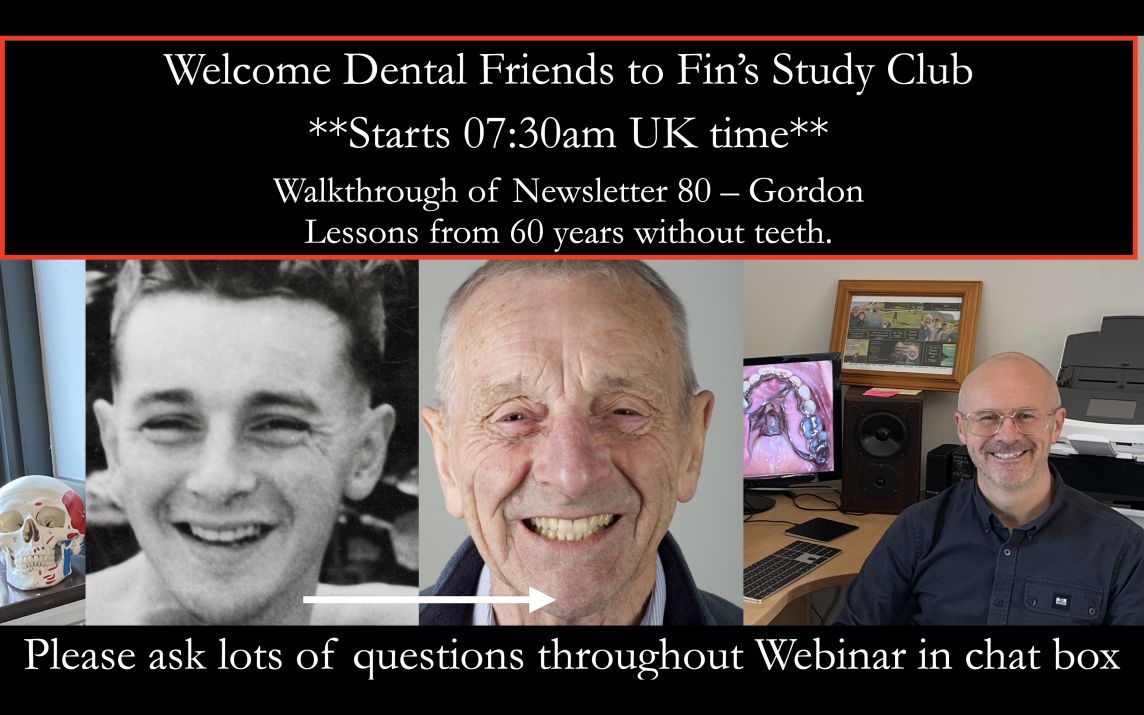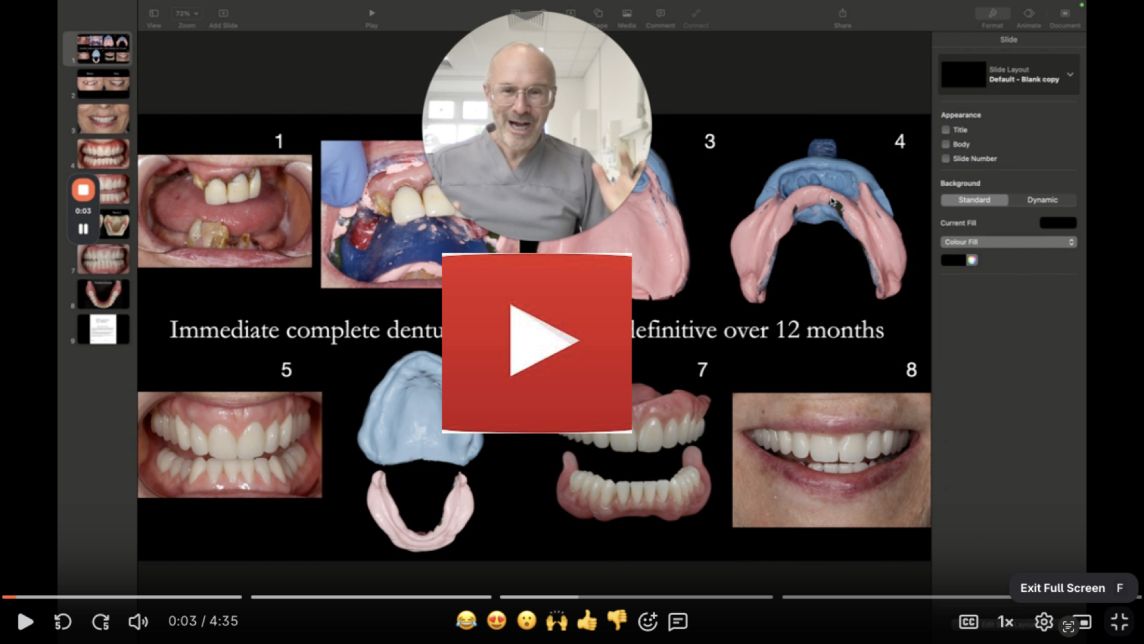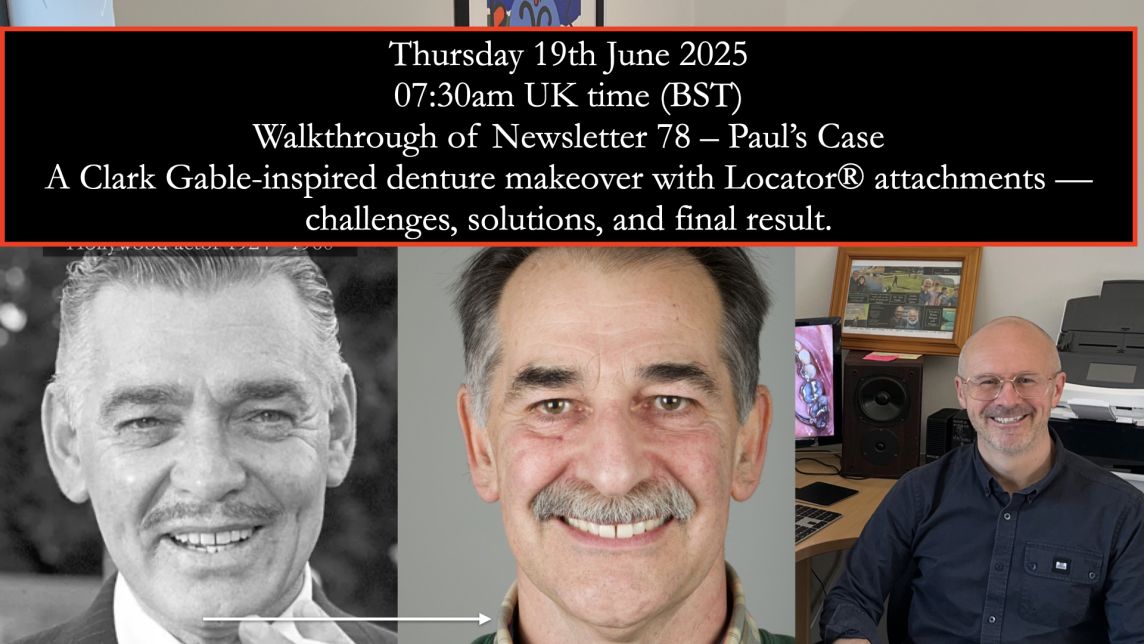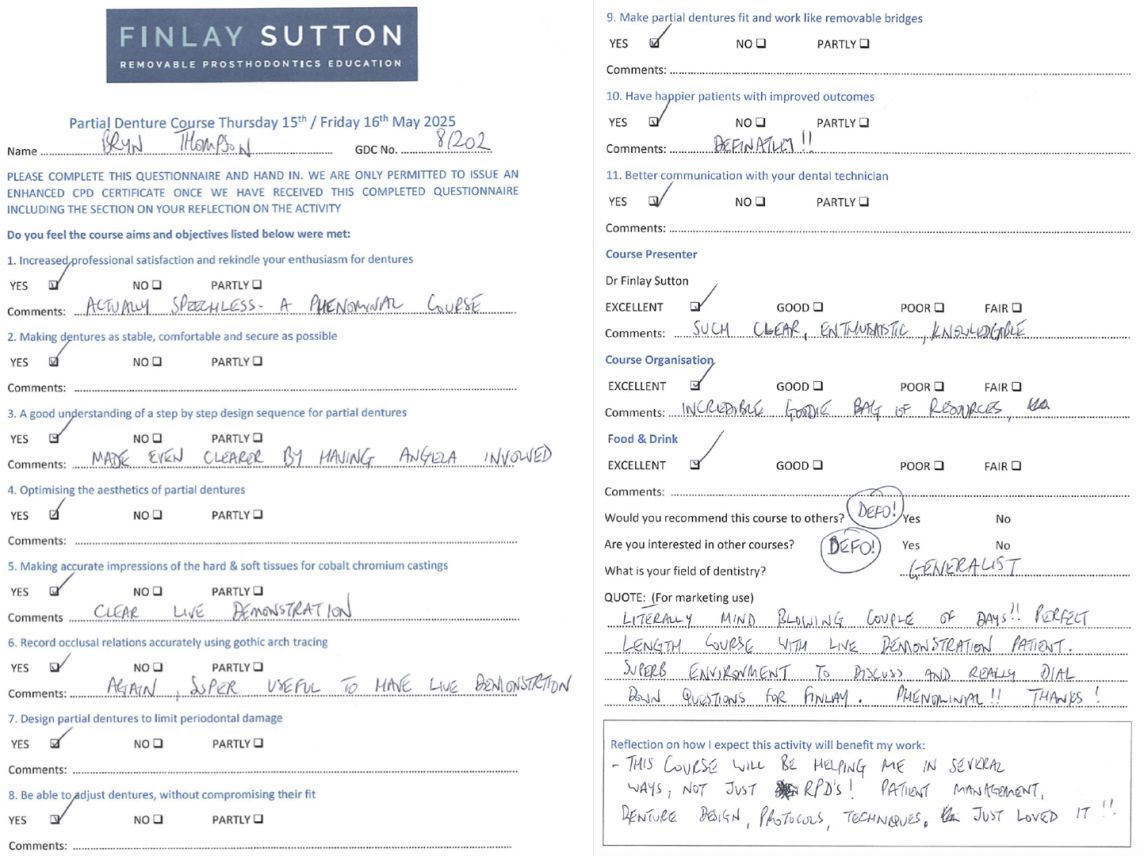If you are a potential patient and would like to enquire about treatment, please visit my clinical practice website. You will find information about the practice, examples of my work, and my current clinical fees.
More about me:
I am a specialist prosthodontist based in the northwest of England, and for the past 30 years I have focused my career almost entirely on one very specific area of dentistry: removable prosthodontics. In simple terms, I make dentures. But making dentures that actually work, that fit beautifully, that look completely natural, and that allow people to eat, smile and enjoy life again, is one of the most technically and emotionally demanding areas of dentistry.
My journey into dentistry began in 1989 at Sheffield Dental School. When I first treated patients as a young undergraduate in 1990, I quickly realised that real dentistry on real people was far harder than I had ever imagined. Technically challenging, emotionally demanding, and often very stressful. Managing patients, trying to relax them, while carrying out delicate procedures was something I found incredibly difficult at first. Although I passed my exams and qualified in 1993, I left dental school knowing I still had a lot to learn.
My first year in practice, in Cumbria, was very hard. I found general practice stressful and often demoralising. I didn't enjoy it. Determined to improve, I started attending many postgraduate courses. A pivotal moment came in 1997 when I took a one-year course with Michael Wise in London. For the first time, I saw dentistry done to an extraordinarily high standard, with absolute precision, care and attention to detail. Michael worked closely with his in-house technician, Tony Laurie, which fascinated me. But while this opened my eyes to what was possible, I still didn’t know how to get there myself.
By 1999, six years into general practice, I was on the verge of quitting dentistry completely. I was burnt out, disillusioned, and struggling to give patients outcomes I was truly happy with. After a long phone call with my father, I decided to give it one last try and invest in my training. I applied to study for an MSc in Fixed and Removable Prosthodontics at the University of Manchester.
That year changed everything. I was taught by Professor Fraser McCord, who was a brilliant but extremely tough mentor. In truth, he told me I was not very good at the start, which was hard to hear but entirely fair. It gave me the wake-up call I needed to properly focus, study, and commit to mastering my craft. I spent long hours in the library, in clinics, and in the lab, determined to improve. During this time I met Rowan Garstang, chief prosthodontic technician at Manchester, who lived locally. We immediately developed a close working relationship, and to this day Rowan remains my technical partner, working side-by-side with me in the room next door.
After completing my MSc, I worked briefly as a lecturer at Manchester, but Professor McCord told me that to become truly skilled I needed full specialist training. I enrolled on a 5-year Specialist Registrar training programme at Liverpool Dental Hospital in Restorative Dentistry, which included prosthodontics, periodontics, endodontics, and advanced complex cases involving trauma, cancer, cleft lip and palate, and hypodontia.
During this time, I also completed a PhD, running a randomised controlled clinical trial comparing different occlusal schemes for complete dentures. This intensive period gave me exposure to some of the most challenging restorative cases imaginable, and I am deeply grateful for that training. Ironically, one of my weekly duties at Liverpool was the Implant Review Clinic, where I saw endless complications. That experience helped form my long-term view that, while implants are valuable, well-made removable prosthetics remain an essential treatment modality.
By 2007, I had completed my specialist training and, along with Rowan, took the leap to establish my own dedicated specialist referral practice in Garstang. I began by hiring a small room within Stainer House Dental Practice—a well-established private practice in the town—where I worked for around two years with Claire, my fantastic dental nurse. During this time, Rowan and I were also operating a small dental laboratory above a shop in Garstang, which had once been my father's shop. The lab was just a short walk from the practice, and this close setup allowed us to build a highly responsive service. Slowly but surely, we built up the service and momentum started to grow.
In 2009, a significant opportunity arose when the old Garstang Courthouse came up for sale. The building was the perfect size to create a purpose-built specialist practice with space for both clinical work and teaching. I purchased the building, converted it, and opened Garstang Dental Referral Practice in April 2010. Around this time, my wife Rachel, a specialist orthodontist, joined the practice, along with an endodontist, allowing us to offer a comprehensive specialist service.
Rachel has been a huge part of this journey. Her support has been unwavering—from setting up the practice together to navigating the many ups and downs of clinical life. She is calm, insightful, and completely grounded. We share a love of golf and often escape to the course together, which brings us both great joy. We make a good team—at work and at home.
We also have two brilliant boys, Zach and Oscar, who bring so much energy, fun and love into our lives. Being a dad to them is one of the greatest privileges of all. I love watching them grow, seeing their personalities emerge, and spending time with them however we can—whether that’s hanging out, watching them play football (soccer), playing golf, going to the gym, or travelling together.
Over time, I found myself increasingly drawn to removable prosthodontics. Although I was well trained and competent in fixed prosthodontics, I simply enjoyed removable work more and found I was better at it. In 2014, after a particularly difficult fixed implant-supported case involving a highly litigious patient, I made the major decision to limit my practice exclusively to removable prosthodontics. At the time, this felt like a significant risk—would I receive enough referrals? But the decision proved absolutely right. My practice flourished, my clinical outcomes improved, and both Rowan and I continued to refine our techniques.
That same year, in 2014, I began working with a clinical psychologist to help me process the emotional impact of that difficult case. What began as a short-term consultation has turned into a long-term, ongoing relationship that continues to this day. With his help, I developed vital coping mechanisms for dealing with the emotional intensity of clinical dentistry. He encouraged me to build a strong professional support network, which led to the creation of the Besford Study Club—a trusted circle of colleagues I can turn to for guidance and perspective.
He also introduced me to mindfulness-based cognitive behavioural therapy, which taught me how to manage the anxiety I often feel when driving to work, unsure what the day might bring. More recently, I’ve found self-hypnosis techniques, especially those promoted by Paul McKenna, to be incredibly helpful in managing emotionally triggering situations—such as complaints that feel personal.
My psychologist also encouraged me to prioritise physical wellbeing. I now do circuit training three times a week in Lancaster with a supportive group of people, run regularly, go to the gym with my son, and play badminton every Wednesday with a group of friends. I do parkrun every Saturday. I’ve also given up drinking alcohol—something I’ve not done now for four years—and I’ve found this lifestyle change hugely beneficial. I try to live healthily in every sense.
In 2010, I also met Dr John Besford for the first time, attending his complete denture course, which was transformative. John’s approach and philosophy deeply influenced me, not only technically but in the way I think about patient care, aesthetics, and what is truly possible with removable prosthodontics. We later founded the Besford Study Club—a group of 15 like-minded dentists who share a passion for high-quality removable work. John remains an inspiration and mentor to this day.
In addition to clinical practice, I now dedicate a large part of my time to teaching and writing. I typically treat patients two days a week, with one day for new patient consultations via phone or Zoom. The remaining time I devote to teaching dentists, technicians and CDTs at all stages of their careers, and to writing textbooks that capture everything I have learnt, to help others reproduce these techniques clearly and predictably.
One of my great joys is teaching live clinical demonstrations in my own practice, with real patients, so that delegates can see every step in detail. I also regularly teach across the UK, Europe and internationally. My mission is simple: to show that removable prosthodontics is a highly valid, often superior treatment option for many patients—even in an era dominated by dental implants. Many patients either cannot have implants due to medical reasons (such as long-term bisphosphonate use), do not want surgery, or have suffered complications from failed implant treatment. I love being able to help these people.
Another significant influence on my practice has been Charlotte Stilwell, who introduced me to the Scandinavian approach to partial denture design. This has been nothing short of a game changer. Compared to traditional British teachings, the Scandinavian hygienic design offers superior comfort, stability, periodontal support, and longevity. My average number of post-insertion reviews for partial dentures has dropped to 1.5 visits, allowing me to treat more patients and ultimately increasing the financial sustainability of my practice. It has also led to fewer caries and periodontal problems for patients, particularly for those with compromised teeth, as the partial denture acts like a splint to support weakened teeth.
I love mentoring too—whether that’s in person at my practice or online via Zoom. I work with dentists around the world, from newly qualified clinicians to experienced specialists, helping them develop their skills and confidence in removable prosthodontics. Seeing someone thrive and grow in their work is one of the most rewarding parts of what I do.
One of my favourite parts of each month is writing my newsletter. It features a single case, written up from start to finish in a clear, step-by-step format. I usually write it on a walk into Lancaster, sitting with a good coffee at the Hall café. Hitting ‘send’ and sharing it with the world always gives me a buzz. Alongside the newsletter, I run a free Zoom-based Study Club once a month, open to all. In it, I talk through the case in detail and answer questions—it's an open, friendly and honest space to learn.
I also run in-depth paid courses from my practice and at venues around the UK and internationally. The fees are high—higher than most other courses in dentistry—but I believe they reflect the value. They are incredibly practical, totally clinical, and grounded in real-life casework. I’m open about the challenges, the mistakes, and the learning points. I don’t pretend it’s easy. I just show what has worked for me and how I’ve improved over time. When I lecture or teach, I charge a high fee because I give everything I’ve got, and the results are, I hope, truly valuable.
At the same time, I try hard to remain humble. I don’t claim to have all the answers, and I’m not perfect—far from it. I’ve made plenty of mistakes and I’m happy to talk about them, because that’s how we all learn. I see myself as a work in progress. Always learning. Always evolving.
Outside of dentistry, I love travelling, seeing different cultures, and experiencing what the world has to offer. I’m endlessly curious. I love music and have a beautiful record player at home, which brings me a lot of joy. I enjoy going to gigs, spending time with friends from all sorts of different backgrounds, and simply appreciating life’s richness.
I feel extremely fortunate to have had the mentors, opportunities, and experiences that have shaped my professional life. And above all, I remain committed to constantly learning, improving, and sharing everything I know with others.





